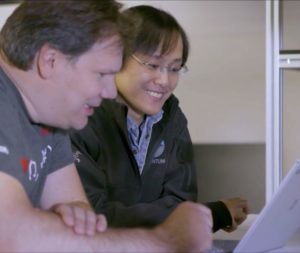 In this video, the Microsoft Quantum Team describes how Quantum computers have the potential to solve the world’s hardest computational problems and alter the economic, industrial, academic, and societal landscape. In just hours or days, a quantum computer can solve complex problems that would otherwise take billions of years to solve.
In this video, the Microsoft Quantum Team describes how Quantum computers have the potential to solve the world’s hardest computational problems and alter the economic, industrial, academic, and societal landscape. In just hours or days, a quantum computer can solve complex problems that would otherwise take billions of years to solve.
To unlock these potential applications, the Microsoft Quantum Development Kit includes a new chemistry library that allows chemists to simulate molecular interactions and explore quantum algorithms for real-world applications in the chemistry domain. Features included in the library are state-of-the-art Q# implementations of methods for Hamiltonian simulation – including Trotterization and Qubitization techniques – state preparation techniques, and samples to help chemists to get started quickly.
For example, the 100-year-old Haber-Bosch process, a key industrial process to create artificial fertilizers, might be improved using computational chemistry methods that are enhanced by quantum computing. That could improve the catalytic process for creating ammonia from atmospheric nitrogen, a process that currently requires high temperatures, high pressures, and carefully selected catalysts. This process is so heat- and pressure-intensive that it consumes upwards of two percent of the world’s natural energy sources. Using quantum algorithms such as those supported by the Microsoft Quantum chemistry library, scientists can learn from nature’s natural process of nitrogen fixation how to achieve this task at lower pressures and temperatures.
The Microsoft Quantum Development Kit chemistry library was developed in collaboration with Pacific Northwest National Laboratory (PNNL), a leader in both chemistry and data analytics. The chemistry library – working with PNNL’s NWChem, an open-source, high-performance computational chemistry tool developed by the U.S. Department of Energy’s Office of Science – enables quantum solutions to solve computationally complex chemistry problems.
Watch this video made with Pacific Northwest National Laboratory:
“Quantum computing has the potential to help us answer our questions much, much faster with much higher accuracy.” Wendy Shaw, Director, Physical Sciences Division, Pacific Northwest National Laboratory
Today, developers and chemists around the world can begin exploring the Microsoft Quantum Development Kit and experiencing the world of quantum computing. Resources such as the chemistry library will enable problem-solvers in the computational chemistry domain to explore the world of quantum. We’re excited to help our growing community take another step toward the new world of quantum computing.




